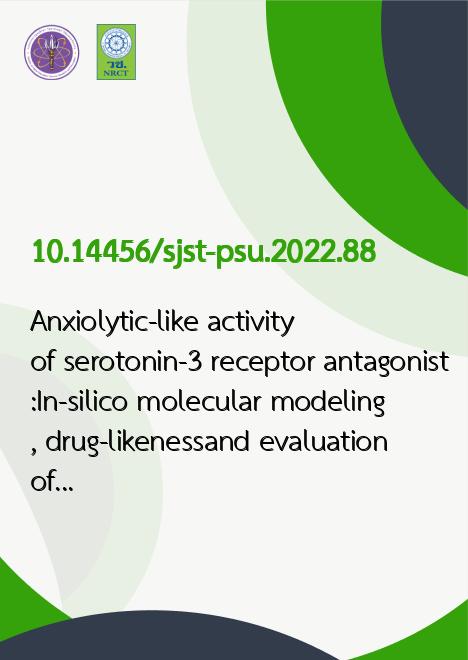
|
Anxiolytic-like activity of serotonin-3 receptor antagonist:In-silico molecular modeling, drug-likenessand evaluation of anxiolytic activity |
|---|---|
| รหัสดีโอไอ | |
| Creator | 1. Venkatesha Perumal Ramachandran 2. Revathi Rajappan |
| Title | Anxiolytic-like activity of serotonin-3 receptor antagonist:In-silico molecular modeling, drug-likenessand evaluation of anxiolytic activity |
| Publisher | Research and Development Office, Prince of Songkla University |
| Publication Year | 2565 |
| Journal Title | Songklanakarin Journal of Science an Technology (SJST) |
| Journal Vol. | 44 |
| Journal No. | 3 |
| Page no. | 646-652 |
| Keyword | 5-HT3 receptor antagonist, anxiolytics, molecular docking, ADMET |
| URL Website | https://rdo.psu.ac.th/sjst/index.php |
| ISSN | 0125-3395 |
| Abstract | Serotonin-3 receptor antagonists have a significant impact in treating nausea and vomiting, and various diseases of thecentral nervous system. Patients receiving chemotherapy have anxiety as one of their complications. Therefore, we explored theanxiolytic effect of the test compound, 6d {2-[4-(prop-2-en-1-yl)piperazin-1-yl]-1,8-naphthyridine-3-carbonitrile}, and thestandard 5-HT3 receptor antagonist, ondansetron. In this research, we carried out computational study to predict drug-likenessand bioactivity using online prediction tools. In-silico molecular docking studies were performed with the four conformations of5-HT3 receptors using AutoDoc Vina software and binding interactions were analyzed using Biovia Discovery Studio. Anxiolyticstudies were conducted in mice using various animal models. Both the test and standard drug satisfied Lipinski and Veber rules,showed high oral absorption and blood-brain barrier permeability. In the toxicity prediction, the test compound showed higherLD50 compared to ondansetron and did not display other toxicities, whereas ondansetron exhibited mutagenicity. Docking studiesrevealed that the test compound has higher binding affinity with F, I1 and T conformations and lesser binding affinity with I2conformation compared to ondansetron. Anxiolytic evaluation disclosed that the test compound and ondansetron exhibitedsignificant anxiolytic activity at 10 mg/kg dose compared to saline control. |
